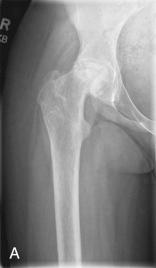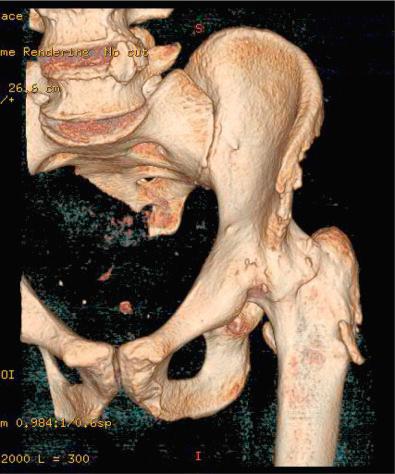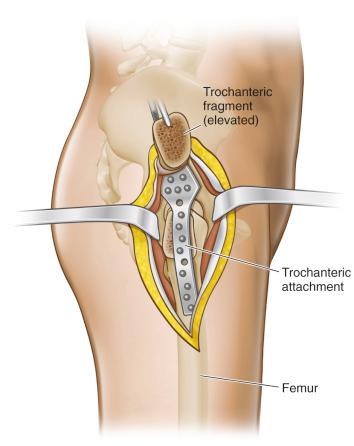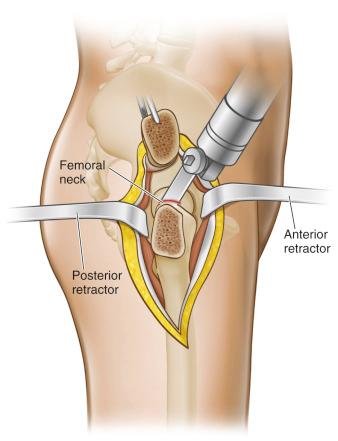Physical Address
304 North Cardinal St.
Dorchester Center, MA 02124
Conversion of a previously arthrodesed hip to total hip replacement is indicated for pain relief in surrounding joints (low back, ipsilateral knee, contralateral hip). However, patients may also seek conversion because of the disability related to an immobile hip or before undergoing ipsilateral total knee replacement.
Surgical exposure is dependent on the type of arthrodesis and presence and location of hardware but typically requires a more extensile approach (standard or extended trochanteric osteotomy or trochanteric slide). The inferior aspect of the acetabulum is the most important landmark to help with preparation and placement of the socket.
Abductor strength may continue to improve for 2 to 3 years after conversion.
Range of motion remains restricted compared with conventional primary total hip replacements.
Full function, without pain or the use of walking aids, and a negative Trendelenburg sign can be obtained but in only a minority of cases. A large majority of patients are satisfied with the result of their conversion.
Best outcomes are seen in patients whose abductors have not been violated during prior surgery (spontaneous arthrodesis or fusions performed sparing the abductors).
Changing patient expectations and improved results with hip replacement have led to a decreased demand for hip arthrodesis. Fusion of the hip is now rarely performed for end-stage degenerative hip disease. Nevertheless, hip fusion allows for long-term pain relief and provides adequate function for individuals who may not be candidates for total hip replacement. However, the disability resulting from an arthrodesed hip may result in the need for conversion of the fused hip to a total hip replacement over time.
Total hip replacement after previous hip arthrodesis is a challenging procedure. It may be considered in patients who have developed pain and disability in surrounding joints because of increased stress placed on these joints by the stiff hip. Long-term sequelae of hip arthrodesis include an increased incidence of pain and degenerative changes in the lumbar spine, ipsilateral knee, and contralateral hip.
Indications for conversion of an arthrodesed hip to a total hip replacement most commonly include disabling low back pain, ipsilateral knee pain, and contralateral hip pain. Increased degenerative changes occur in these joints owing to increased stress placed through the joints juxtaposed to the fused hip. Poor range of motion (ROM) after knee replacement in patients with ipsilateral hip arthrodesis has been documented, and conversion of the fused hip to a mobile hip before knee replacement has been advocated by some authors.
Although pain in the fused hip typically is not an indication for surgery, increasing pain from a pseudarthrosis and functional disability from a malpositioned arthrodesis are additional indications for conversion.
Last, and perhaps now more commonly, even in the absence of the previous indications, patients may seek conversion of an arthrodesed hip to a mobile hip replacement as they become less willing to accept the inconvenience and increased energy expenditure during gait that an arthrodesed hip places on activities of daily living.
Alternatives to conversion of an arthrodesed hip relate to treatment of the symptomatic joint or joints around the fused hip. Generally, conversion of the fused hip is undertaken after nonoperative treatment of these joints has failed. Failed nonoperative management of low back pain is the most common reason for conversion. Surgical treatment of mechanical low back pain should not be considered until after conversion of a fused hip is performed. Surgical management of mechanical low back pain before conversion of a fused hip is much less likely to be successful owing to ongoing stress placed through the lumbar spine because of the fused hip. Pain relief in the ipsilateral knee or the contralateral hip is less predictable after conversion of a fused hip (see “ Results ”), and surgical treatment may be required before or after conversion of the fused hip depending on the severity of symptoms and degenerative changes in these joints.
Absolute contraindications to conversion of an arthrodesed hip are similar to those for primary or revision hip replacement surgery. Active or suspected infection and poor medical health are contraindications to this surgery. Relative contraindications include young age in a patient in whom the hip is fused in an acceptable position (20 degrees flexion, 5 degrees external rotation, neutral abduction/adduction), particularly if returning to heavy labor; severely distorted anatomy that would preclude restoration of near-normal biomechanics or would place the hip replacement at high risk of failure; and poor or absent abductor musculature.
Patients who expect complete or near-complete relief of symptoms in surrounding joints or a normally functioning hip replacement must be counseled as to the outcome of conversion of an arthrodesed hip to a hip replacement (see “ Results ”). Typically, results are not comparable with those of primary hip replacement, and although improvement is noted in the symptoms of surrounding joints, particularly low back pain, complete relief of symptoms is less likely.
Routine preoperative radiographs (anteroposterior [AP] pelvis, AP hip, and true lateral hip) are usually the only imaging studies required preoperatively, provided that no significant distortion of anatomy or usual placement of hardware is noted ( Fig. 83.1 ). If distorted anatomy is present (e.g., extraarticular arthrodesis, large amount of heterotopic bone), a preoperative computed tomography (CT) scan is helpful for defining anatomy, localizing retained hardware, and for identifying bony landmarks ( Fig. 83.2 ).


Electromyography is not routinely required in the preoperative evaluation of abductor function. The use of electromyography to assess gluteal muscle function is of limited value and does not correlate well with postoperative abductor function. Postoperative abductor muscle function can be best predicted by preoperative palpation of contracting abductor musculature and, more important, by intraoperative assessment of muscles. The intraoperative assessment has been shown to correlate well with return of postoperative abductor function. Even severely atrophied muscle can recover acceptable function if it otherwise appears intact and healthy (bleeding and red in appearance). The type of fusion procedure will also influence return of abductor function. Abductor-sparing hip arthrodeses (those not involving a trochanteric osteotomy or significant abductor violation) should result in more predictable return of abductor function.
Additional equipment, apart from that required for insertion of the implants, should be available. Metal cutting burs, broken screw extractors, and fluoroscopy may be required to remove hardware or to identify bony landmarks. Additionally, the surgeon should be familiar with the technique that was used for the arthrodesis, as this may influence the exposure and need for bone removal, particularly with an extraarticular arthrodesis.
Conversion of a hip arthrodesis to total hip replacement is a technically demanding procedure. Important technical considerations include adequate exposure with maintenance or restoration of abductor function, removal of hardware, if present, and careful identification of bony landmarks to ensure proper implant orientation.
Positioning is done by surgeon preference but typically will be dictated by the type of approach and location of hardware used during the fusion. Commonly, the patient is placed in a lateral position, as this allows for a more extensile exposure if required. A supine position is used if a direct anterior approach is chosen or is required to remove anteriorly placed hardware. The skin incision is partially dictated by the previous incisions and the need for hardware removal. If no incision is present, a lateral incision is used, centered over the posterior trochanter and curving posteriorly at the proximal end. Any hardware overlying the trochanter and the proximal femur is removed. If a previous trochanteric osteotomy was performed at the time of fusion, and hardware is beneath the trochanter and the outer table of the pelvis (e.g., Cobra plate), then a classic trochanteric osteotomy is required ( Fig. 83.3 ). Otherwise, a standard posterior approach or a trochanteric slide with retraction of the trochanteric fragment anteriorly generally provides sufficient exposure and reduces additional trauma to the abductors. A short extended osteotomy, with soft tissue attachments maintained, may be preferred to facilitate closure and healing of the osteotomy. A longer extended osteotomy may be required if a proximal femoral deformity requiring correction is present. If a trochanteric fragment is absent because of previous surgery, a posterior approach with anterior elevation of the remaining abductors, along with the anterior portion of the vastus lateralis, can be used. Soft tissues are then further cleared from the arthrodesis and the proximal femur for identification of the femoral neck. If a bony bridge exists between the femur and the ischium, the bridge is osteotomized and resected before or after osteotomy of the femoral neck. Care should be taken to protect the sciatic nerve in this region. The femoral neck is then identified and retractors placed around the neck anteriorly and posteriorly ( Fig. 83.4 ). The initial in situ femoral neck osteotomy can be made more proximally than the anticipated final cut, and further release of soft tissues around the proximal femur improves exposure. Based on preoperative templating and identification of bony landmarks (the greater or lesser trochanter), a revised and definitive femoral neck cut is then performed. A slightly lower neck cut provides additional exposure to prepare the acetabulum.


Become a Clinical Tree membership for Full access and enjoy Unlimited articles
If you are a member. Log in here